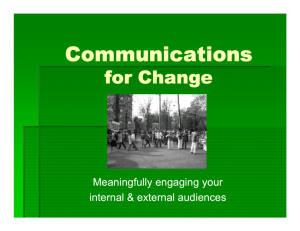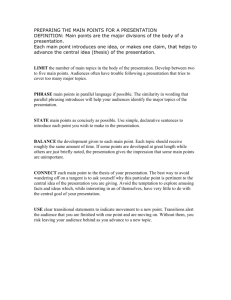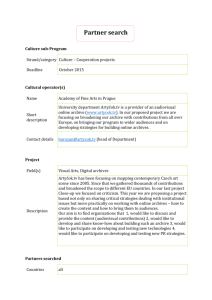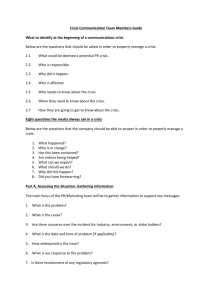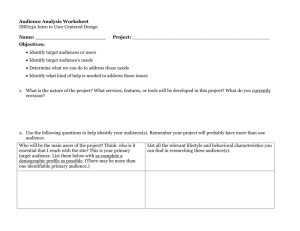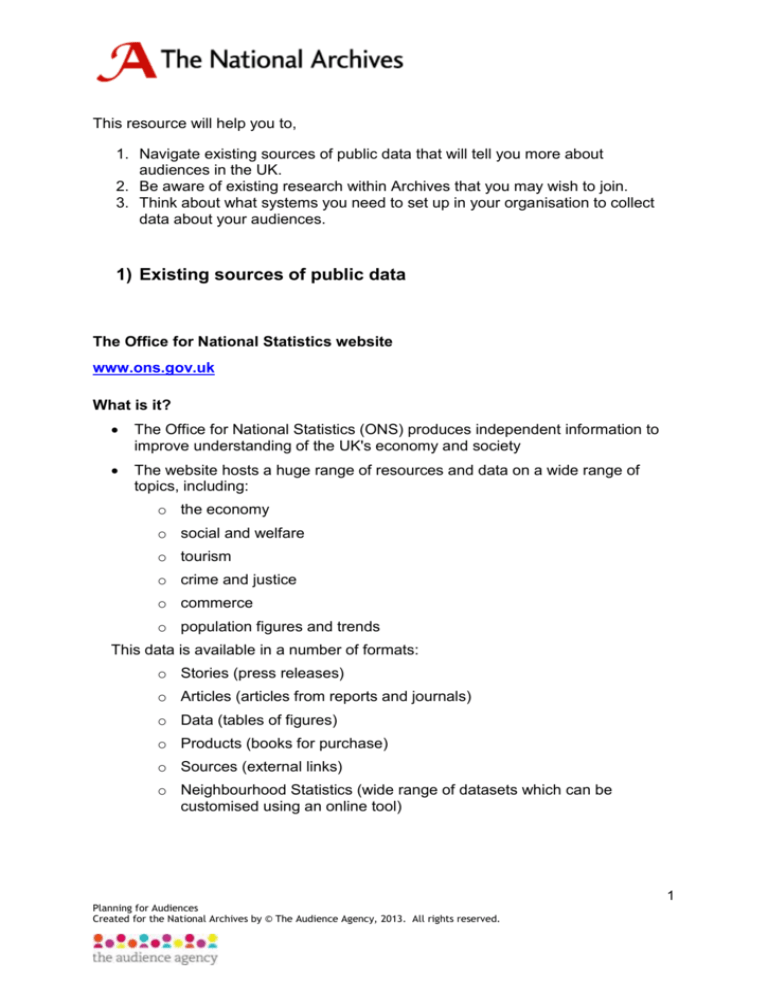
This resource will help you to,
1. Navigate existing sources of public data that will tell you more about
audiences in the UK.
2. Be aware of existing research within Archives that you may wish to join.
3. Think about what systems you need to set up in your organisation to collect
data about your audiences.
1) Existing sources of public data
The Office for National Statistics website
www.ons.gov.uk
What is it?
The Office for National Statistics (ONS) produces independent information to
improve understanding of the UK's economy and society
The website hosts a huge range of resources and data on a wide range of
topics, including:
o the economy
o social and welfare
o tourism
o crime and justice
o commerce
o population figures and trends
This data is available in a number of formats:
o Stories (press releases)
o Articles (articles from reports and journals)
o Data (tables of figures)
o Products (books for purchase)
o Sources (external links)
o Neighbourhood Statistics (wide range of datasets which can be
customised using an online tool)
Planning for Audiences
Created for the National Archives by © The Audience Agency, 2013. All rights reserved.
1
Pros and cons
Lots of data from a variety of sources
Data generally very robust
Uses standard government measures, so the data is widely comparable with
other sources
Versatile – can give you overviews of particular subjects, new research, or
your own customised tables and charts
Takes a bit of time to get used to using Neighbourhood Statistics
Not much culture-specific content; more useful for building up a picture of an
area according to other measures (for instance education, access to services
etc)
Where can I find the data?
Browse through themes from the homepage (www.ons.gov.uk)
Search for reports from the homepage (www.ons.gov.uk)
Click “Neighbourhood” on the homepage (or go to
http://neighbourhood.statistics.gov.uk/dissemination/) to be taken to
Neighbourhood Statistics, where you can create customised tables and charts
Using the ONS Neighbourhood Statistics tool
Neighbourhood Statistics enables you to make your own charts and tables based on
the wide variety of data ONS hold. You can look at your data by geographical area,
so you can isolate particular areas of interest, or identify which areas have particular
characteristics. Follow the walk-through to get to grips with the basics, and spend a
bit of time seeing how it might be able to help you.
There are two ways to get data from Neighbourhood Statistics. The first method is
the quickest way to get data out for a preset area – perhaps a particular borough, or
a ward within a borough – and compare it to other preset areas within the region:
1. Go to http://neighbourhood.statistics.gov.uk/dissemination. If you want to find
out information about a particular area, enter a postcode, or the name of the
borough or ward in which you’re interested, in the box, and choose the type of
area you want statistics for :
Planning for Audiences
Created for the National Archives by © The Audience Agency, 2013. All rights reserved.
2
In the example above, choosing ‘Local Authority’ will give you data for
Southwark (the borough SE1 3ER is within), and choosing ‘Ward’ would give
you data for Grange, which is the ward SE1 3ER is in. This also decides what
the data you get is compared to – if you get data for a Local Authority it will be
compared with all the other LAs in the region (so in this example Southwark
will be compared with all the other London boroughs), and if you get data for a
Ward it will be compared with all the other wards within that local authority. All
will become clear once we see the maps…
2. After choosing the area you’re interested in, all available data for that area will
be shown. Click through to the topic you’re interested in…
Planning for Audiences
Created for the National Archives by © The Audience Agency, 2013. All rights reserved.
3
3. Your data will look something like this
Planning for Audiences
Created for the National Archives by © The Audience Agency, 2013. All rights reserved.
4
Form this screen, you can:
o Find out more about the data (where it came from etc) by clicking About
this dataset
o Depending on the data, view it over a different time period by clicking on
the Period drop-down
o Save the data to your computer by clicking Download the table
o Show the data on a map by clicking Map this data
4. If you click Map this data, you’ll see something like this:
As we previously chose to view data for a Local Authority, we see Southwark
(highlighted in yellow) compared to the other boroughs in the region. Each is
shaded according to its value on the chosen variable (which in the case above
is counts of violence against the person offences by borough between April
2008 and March 2009).
To see another statistic from the previous table across the boroughs, click
Change variable and pick from the list.
5. Click Advanced tabs to show options for making the map look different. You
can change:
o The colour of the map
o The number of different groupings on the map
o Turning on or off a background map to help you understand where the
different areas are, in the real world
Planning for Audiences
Created for the National Archives by © The Audience Agency, 2013. All rights reserved.
5
o View a graph which shows the same data, but ranked (so the borough
with the highest count is at one end of the chart, and that with the
smallest count is at the other)
These options can help make the map easier to understand.
6. To save the map, either do a screen grab (using the Print Screen button on
your keyboard), or, if you have the necessary software, print it as a pdf.
The second method allows you to be more precise about the areas you’re interested
in, and show data for multiple areas and multiple topics at once. This can be a much
more efficient way of working if you want to pull data for multiple topics and/or
multiple areas.
1. From the Neighbourhood Statistics page
(http://neighbourhood.statistics.gov.uk/dissemination), click Custom - Pick and
mix data to meet your needs
2. First, choose whether you want to start building your data by looking at a
particular area, or start by defining some topics. We’ll start with topics:
Planning for Audiences
Created for the National Archives by © The Audience Agency, 2013. All rights reserved.
6
Click Next to move to the next step.
3. Click through the areas on the left to find the topics you’re interested in:
In this example, I’ve decided I want to know about what percentage of those
within an area are aged 10-24. Click Next to define the area these figures will
be given for...
4. You can either choose to use ready-made areas (for example local
authorities) by picking them form a list or picking them from a map, or creating
Planning for Audiences
Created for the National Archives by © The Audience Agency, 2013. All rights reserved.
7
a custom area. We’ll go for ready-made areas, and get the data we
previously chose for the five Olympic Host Boroughs – click next to continue...
5. On the next screen you need to choose which building blocks your area will
be made of. The default option, NeSS Geography Hierarchy is not very useful
for most purposes. If you’re interested in looking at data for boroughs, chose
2009 Administrative Hierarchy:
6. In the same way as you picked your topics, use the list on the left to find the
area(s) you’re interested in:
Planning for Audiences
Created for the National Archives by © The Audience Agency, 2013. All rights reserved.
8
If you’re basing your selections on the 2009 Administrative Hierarchy you can
choose whole regions, boroughs, or wards within boroughs (or a mix of all
three). Clicking Next will show you the data for the topics you selected for the
areas you’re interested in:
7. From here, you can do lots of things to the data by using the icons on the left
hand side. You can:
o Show it as a chart
o Map it
o Remove columns
o Sort the figures
o Swap the table around, so the rows become columns and vice versa
o Save the table to your computer
The best way of getting used to Neighbourhood Statistics and getting an idea of what
it might be able to do for you is using it, so try playing around and see what happens!
Planning for Audiences
Created for the National Archives by © The Audience Agency, 2013. All rights reserved.
9
The Taking Part survey
https://www.gov.uk/government/organisations/department-for-culture-mediasport/series/taking part
What is it?
A continuous national survey of households in England, commissioned by
DCMS in partnership with English Heritage, ACE, Sport England and MLA
In-home interviews provide information on adults’ (and, since 2008/09, 5-15 yr
olds’) cultural and sport attendance and participation
Launched mid-July 2005
Sample includes adults and children. (2008/09 14,000 adults, 1,000 children
2009/10 6,000 adults, 500 children)
Detailed information available on archives, arts, libraries, museums, galleries,
heritage, sport and internet access includes:
Planning for Audiences
Created for the National Archives by © The Audience Agency, 2013. All rights reserved.
10
attendance and participation
frequency and types of engagement
reasons for attendance / non-attendance
sex
age
household structure
education
work status
income
housing tenure
geographic region
ethnic origin
religion
health
disability
ownership of a motor vehicle
socio-economic group
ACORN type
Pros and cons
Asks detailed questions about peoples’ engagement with culture and sport –
covering attendance and participation
Includes data from under-16s
Lots of research on the dataset already available, which may be able to
answer your questions
All data is free.
You can access a range of types of information Statistical releases e.g. yearly
overview reports to ad hoc research reports e.g. trend analysis
Data only available down to region level – e.g. for London, or the North East –
cannot ‘zoom in’ any further
Smaller sample size in 2009/10 means analysis at a regional level, or on data
from under-16s, is subject to larger margins of error.
Area Profile Reports
http://www.theaudienceagency.org/services/apr
What are they?
Area Profile Reports (APRs) contain data on resident populations. You can use
these reports to find out more about the people living in your local area including
Planning for Audiences
Created for the National Archives by © The Audience Agency, 2013. All rights reserved.
11
data on demographics and arts attendance. The purpose of these reports is to assist
organisations in their marketing planning and strategic development. Data is broken
down by postcode sector allowing you to search for areas where target audiences
live and understand the make-up of your catchment area in detail.
What can they be used for?
Understanding organisational performance against potential
Identifying hot-spots
Understanding cold-spots
Targeting to post-code sector level
Selecting promotional/advertising media
Pros and Cons
Quick targeted way of reviewing what is known about your local area.
Reports are free to National Portfolio Organisations (NPOs) who can request 1 per year.
-
Data is only available down to a region level – e.g. for London or the North East.
-
These cannot be produced in-house. Non NPO’s have to pay £50+VAT per report.
-
Area Profile Reports can take a couple of weeks to be produced, so plan in
advance
Geo-demographic profiling – Mosaic
http://www.experian.co.uk/business-strategies/mosaic-uk.html
What is it?
Geo-demographic profiling explores what people are likely to be like, and how
they might behave, based on where they live
Mosaic segments the neighbourhoods of Great Britain into different lifestyle
‘groups’ and ‘types’ according to their postcode
Segments describe of the typical nature of people living in an area, including
financial circumstances, consumer and leisure habits, values and motivations
It’s important to remember it describes a neighbourhood according to the mix
of individuals or households within it – it’s not saying that everyone with a
certain postcode will be the same ‘sort’ of person, just that they’re more likely
than someone living at a different postcode to have certain attributes.
The segmentation is derived from lots of different data sources:
o Census data (includes age, ethnicity, family relationships, work, health,
transport, commuting etc)
Planning for Audiences
Created for the National Archives by © The Audience Agency, 2013. All rights reserved.
12
o Electoral Roll (more frequent than the census, shows numbers of
resident adults and migration patterns)
o Land Registry (house purchasing and prices)
o County Court Judgements
o Creditworthiness
o Surveys, qualitative research, photographs
You can use it to:
o Understand more about the potential audiences in a particular area
How are people within a mile of my venue likely to enjoy their
free time? Could this be a way in to engaging with them?
o Highlight where those most likely to use your service might live
We’re doing some new and more diverse programming that
includes contemporary dance – whereabouts do contemporary
dance fans live, and what communication methods do they
respond to best?
o Profile your existing audience to find out more about them
Are they representative of my local area?
Below are some examples of the types of information generated by Mosaic Profiling.
These are the characteristics of the Mosaic type Urban Cool, which falls within the
Liberal Opinions group:
Planning for Audiences
Created for the National Archives by © The Audience Agency, 2013. All rights reserved.
13
And this is a map, showing the different Mosaic groups assigned to postcodes
across an area of Kensington and Chelsea/Westminster:
Planning for Audiences
Created for the National Archives by © The Audience Agency, 2013. All rights reserved.
14
Each mark on the map represents on postcode, covering approximately 15
households. The map shows that the area to the south-west is populated mostly by
Alpha Territories households (likely to be very well off, and work in high-powered
jobs) and the south-east populated mainly by Liberal Opinions households.
Pros and cons
Can give you a good indication of the likely qualities of the population of any
geographical area, across a massive range of topics – where they holiday,
what they read, likely financial status, opinions etc
Flexible - can be used to describe an area, in terms of the sorts of people living
there, or can be used to profile some existing data, for example getting a
picture of your current audience by profiling postcodes from your box office or
mailing list
Cost attached to getting detailed data/reports
Quite a lot of postcodes are needed to build an accurate profile (at least 1,000
for a Mosaic Type profile)
Planning for Audiences
Created for the National Archives by © The Audience Agency, 2013. All rights reserved.
15
Where can I find the data?
Broad data available at the Mosaic website (as below)
You can get the Mosaic Type of an individual postcode and also find out more
about each group and type using Experian’s interactive guide, at
http://www.experian.co.uk/marketing-information-services/mosaic-uk-2009interactive-guide.html
You need to register, but it’s free to do so.
You can get a Mosaic profile, at group level, for free by visiting
http://www.experianintact.com/home.aspx. After registering and following the
instructions you will be presented with a data audit, part of which is a Mosaic
profile.
The Audience Agency can also support you to benefit from Mosaic Profiling
Services in the context of developing audiences for your organisation. There
is a cost attached to these services.
The ACE Arts Audiences: Insight segmentation
http://www.artscouncil.org.uk/what-we-do/research-and-data/arts-audiences/artsbased-segmentation-research/
What is it?
A segmentation of the English population, with a focus on cultural attendance
and participation.
Divides the population into 13 types (segments), depending on their level of
engagement with the arts:
o Two types are highly engaged, attending and participating
o Seven types have some engagement
Four of these types attend and participate
Three of these types only participate
o 4 types are not currently engaged
The segmentation describes:
o socio-demographic characteristics
o arts attendance and participation
o other cultural engagement (libraries, museums, archives, cinema)
o participation in sports
o volunteering
o ...and other factors which might help plan an engagement strategy or
marketing plan with a particular segment
Planning for Audiences
Created for the National Archives by © The Audience Agency, 2013. All rights reserved.
16
Profiles are available of areas, showing the proportions of each segment within
a geographical area
Pros and cons
Arts-specific, so can be useful for understanding areas based on the people’s
likely engagement with the arts
Paints a picture of different sorts of arts attenders/participants to make it easier
to visualise your potential audience, and what they are likely to be interested in
Useful for strategic planning and thinking about how to target audiences who
are less engaged currently.
Free reports and supporting materials available to ACE regularly funded
organisations
Only 13 segments compared to Mosaic’s 67, so less targeted
Quite a lot of postcodes are needed to build an accurate profile (at least 1,000
for a Mosaic Type profile)
Where can I find the data?
Data available at topline level is available for free on the Arts Council website
at http://www.artscouncil.org.uk/advice-and-guidance/browse-advice-andguidance/arts-audiences-insight-2011
ACE Arts Audiences: Insight area reports are available. These are reports
focused on a geographical area, where data from the research can be
compared against your own audience data. These are available as individual
reports or as part of an Area Profile Report and there is a cost attached.
2) Sector-specific research groups that you can or may already
be part of
Public Services Quality Group for Archives and Local Studies (PSQG)
PSQG was set up in 1996 as an informal collaborative network for archivists
interested in best practice and quality issues. The PSQG steering group meet
regularly at London Metropolitan Archives with sub-committees also meeting to work
on specific issues, one of which currently is Volunteering. Membership is open to all
and information can be found at http://www.archives.org.uk/si-psqg/public-servicesquality-group-psqg.html
Planning for Audiences
Created for the National Archives by © The Audience Agency, 2013. All rights reserved.
17
CIPFA
CIPFA Social Research offer tools for consultation with users and stakeholders to
build the picture of how services are perceived, used and can be improved to better
meet customer needs. There are a range of library survey tools and a visitor survey
for Archives http://www.cipfasocialresearch.net/archives/
SCONUL
The Society of College, National and University Libraries (SCONUL) is a
membership organisation that represents all university libraries in the UK and
Ireland, as well as national libraries and many of the UK’s colleges of higher
education. You can access research that has been carried out by the organisation
on their website at http://www.sconul.ac.uk/publications.
LibQUAL+®
LibQUAL+® is a suite of services that libraries use to solicit, track, understand, and
act upon users' opinions of service quality. Provided by the Association of Research
Libraries (ARL). the program's main component is a Web-based survey bundled with
training that helps libraries assess and improve library services, change
organizational culture, and market the library. More than 1,000 libraries have
participated in LibQUAL+®. http://www.libqual.org
The National Student Survey
Administered by Ipsos MORI,this is an annual survey that has been conducted since
2005. The survey runs across all publicly funded Higher Education Institutions (HEIs)
in England, Wales, Northern Ireland, and Scotland. Additionally, Further Education
Colleges (FECs) in England and Further Education Institutions (FEIs) in Wales with
directly funded Higher Education students are eligible to participate. The survey asks
final year undergraduates to provide feedback on their courses. One of the 7
sections in the survey is about Learning Resources.
http://www.thestudentsurvey.com
Planning for Audiences
Created for the National Archives by © The Audience Agency, 2013. All rights reserved.
18
3) Thinking about your own systems for Understanding your Audiences
As this resource has shown there are many existing or ‘secondary’ sources of information out there that you can tap into to help
you understand your audiences better. And there are many types of new or ‘primary’ research that you can initiate yourself to
do this too. The most important thing to do to ensure you spend your time most fruitfully is to establish first what it is that you
really want to be able to do. Then you can identify how you can get this information, seeking advice where you need to. This
table below provides an example of how you can approach this process and common areas of understanding that organisations
need in relation to their audiences.
What is it I want to
be able to do?
Understand who my
current audiences are
How might I get this type of information?
•
•
Investigate what the
experience is of my
current audiences
•
Using my own data about audiences to create
mapping and geo-demographic profiling,
examining booking and attendance patterns.
Using existing data about levels of engagement
and participation both within my organisation and
more widely across the sector.
By conducting primary research with event
attenders.
What will help me?
•
Primary data held within my
organisation.
•
The Taking Part Survey about
national levels of cultural attendance
and participation.
Current mailing lists we have could
be used to contact people to ask to
take part in research.
Staff and volunteers during events
briefed to ask questions.
•
•
Planning for Audiences
Created for the National Archives by © The Audience Agency, 2013. All rights reserved.
19
What is it I want to
be able to do?
How might I get this type of information?
Understand where
potential new
audiences may come
from
•
Investigate potential
new audiences
•
•
By defining a geographical area around my
venue and understanding the demographic and
other characteristics of that area, as well as
gaining insight about levels of current
engagement in the arts
Exploring the distribution and concentration of
particular groups of interest,
Understanding general audience trends as a
context for development
Planning for Audiences
Created for the National Archives by © The Audience Agency, 2013. All rights reserved.
What will help me?
•
APR reporting including an Arts
Audiences Insight Segementation of
my area.
•
•
Office for National Statistics.
Local research into contacts and
communities of interest.
Case studies of existing good
practice on The National Archives
website and Culture Hive.
•
20
Setting up systems for your own audience research
There are many options available if you want to conduct your own research with your
audiences to get to know more about them and what they think of the work you are
doing.
The most important things to think about first are,
1) What do you need to know and what would be nice to know?
2) How much time are you asking your audience to give and is it proportionate to
the experience you are giving them.
For example if they are visiting a free exhibition you would not expect to conduct
a 20 minute interview with them, it would be more proportionate to do a 1-2
minute vox-pop interview.
3) How will you present the information you collect afterward and who will be
interested in it?
Our experience has taught us that most people collect too much information and do
not use it to it’s full potential. We encourage people to keep things simple. Below is
an example from a community film festival in Tottenham that was managed by Film
London in partnership with the London Borough of Haringey in 2012.
Planning for Audiences
Created for the National Archives by © The Audience Agency, 2013. All rights reserved.
21
This card took 1-2 minutes to fill in and resulted in the project being able to prove
that,
The project had attracted an intergenerational audience, with audience
members ranging from 7-75 years old.
The project that attracted new audiences to Tottenham to watch film; 71% (123
people) of the 170 people that filled in a feedback card told us they had not
watched a film in the cinema or at a screening in the borough in the last 12
months.
The project had attracted local residents.
The project had brought new audiences into the borough with people coming
from 20 other London boroughs as well as other areas of the UK.
The project demonstrated an appetite for screening films in community settings
in Haringey, with a range of audience feedback comments requesting more
regular activity of this kind in the borough.
Planning for Audiences
Created for the National Archives by © The Audience Agency, 2013. All rights reserved.
22



